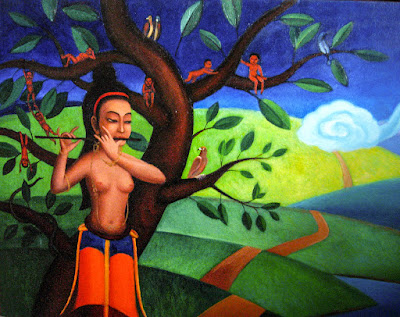The Galleria of my Hovel in Zaisan Tolgoi. The center hanging is by artist Anunaran. (click on photos for enlargements)
Painting in my Galleria by artist Soyolma
Detail of painting in my Galleria by artist Soyolma
Painting of fierce female deity Narkhajid in my Galleria by artist Soyolma
Detail of painting of Narkhajid in my Galleria by artist Soyolma.
Detail of painting of Narkhajid in my Galleria by artist Soyolma.
Painting of Narkhajid in my Galleria by artist Soyolma.
Detail of painting of Narkhajid in my Galleria by artist Soyolma. In her left hand is a cup made from a human skull. The cup is filled with blood. This is one lady you do not want to mess with.
Tara-like painting by Soyolma, apparently a composite of White Tara and Green Tara. Like Green Tara she is bathykolpian, but is holding a lotus in her right hand like White Tara. White Tara also by tradition has a eye in the palm of her outstretched left hand. Here she is holding instead an enigmatic figure of a young woman. Also, White Tara is usually portrayed sitting in a full lotus position; Green Tara usually has one leg hanging down. The figure in this painting seems to be sitting in a rather loose half lotus position halfway between the postures of traditional White and Green Taras. Thus she would seem to be indicative of both.
Painting by Soyolma
Painting by Soyolma. As can be seen in the two paintings above, small figures dwelling in trees are a staple of Soyolma’s work.
Detail of painting by Soyolma
Painting by Soyolma
Soyolma also does traditional thangkas. This is her White Tara, also in my Galleria.




































